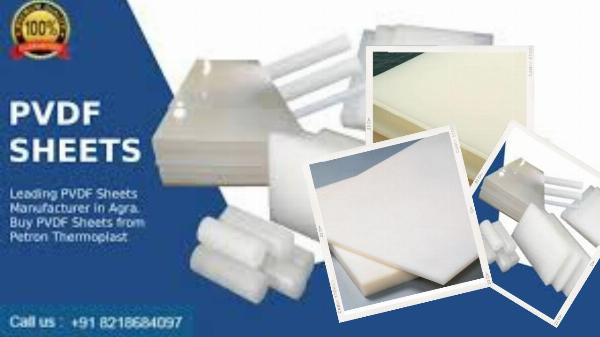PVDF Sheets: A Comprehensive Overview

Strong 8k brings an ultra-HD IPTV experience to your living room and your pocket.
PVDF (Polyvinylidene Fluoride) sheets are versatile, high-performance thermoplastic products known for their remarkable properties and wide range of industrial applications. These sheets are prized for their chemical resistance, mechanical strength, and durability. This article delves into the properties, advantages, disadvantages, industrial applications, and other essential aspects of PVDF Sheets.
Properties of PVDF Sheets
Chemical Resistance: PVDF sheets offer excellent resistance to a wide array of chemicals, including acids, bases, and organic solvents. This makes them suitable for use in harsh chemical environments.
Mechanical Strength: PVDF exhibits high tensile strength and impact resistance, ensuring durability in demanding applications.
Thermal Stability: PVDF sheets maintain their mechanical properties over a wide temperature range, typically from -40°C to 150°C (-40°F to 302°F).
UV Resistance: PVDF is resistant to ultraviolet (UV) radiation, preventing degradation and discoloration when exposed to sunlight.
Low Permeability: The material has low permeability to gases and liquids, making it ideal for applications requiring high purity and containment.
Electrical Properties: PVDF is a good insulator with excellent dielectric properties, suitable for electrical and electronic applications.
Advantages of PVDF Sheets
Durability: PVDF sheets are highly durable and can withstand physical and environmental stress, ensuring a long service life.
Chemical Resistance: The exceptional chemical resistance makes PVDF sheets suitable for use in aggressive chemical environments without risk of corrosion.
Thermal Stability: PVDF retains its properties at both high and low temperatures, making it versatile for various applications.
UV Stability: PVDF sheets do not degrade under UV exposure, making them ideal for outdoor applications.
Purity: The low permeability and high purity of PVDF make it suitable for applications in the pharmaceutical and food industries where contamination must be avoided.
Disadvantages of PVDF Sheets
Cost: PVDF sheets can be more expensive compared to other thermoplastics, which might be a consideration for budget-sensitive projects.
Machining Difficulty: Due to its toughness, PVDF can be more challenging to machine and process compared to other plastics.
Limited Color Options: PVDF sheets are typically available in fewer color options, which may limit their use in certain aesthetic applications.
Industrial Applications of PVDF Sheets
Chemical Processing: PVDF sheets are used in tanks, piping systems, and lining for chemical processing equipment due to their corrosion resistance.
Electronics: The electrical insulating properties make PVDF suitable for use in the electronics industry for components such as insulators and dielectric films.
Water Treatment: PVDF sheets are used in the manufacture of filtration membranes and equipment for water and wastewater treatment.
Pharmaceutical and Food Industries: The high purity and chemical resistance of PVDF sheets make them ideal for use in equipment and containers in these industries.
Automotive: PVDF is used in automotive applications for parts that require high chemical resistance and durability.
Other Essential Points
Fabrication Techniques: PVDF sheets can be fabricated using various techniques, including welding, thermoforming, and machining, allowing for a wide range of custom applications.
Regulatory Compliance: PVDF sheets often meet stringent regulatory standards for use in food and pharmaceutical applications, ensuring safety and reliability.
Sustainability: PVDF is recyclable, contributing to more sustainable industrial practices and reducing environmental impact.
Petron Thermoplast is a leading dealer and exporter specializing in high-quality thermoplastic products, catering to a diverse array of industries. Renowned for their expertise in providing industrial-grade solutions, they offer an extensive range of products, including ball valves, known for their durability and reliability.
FAQs
1. What are PVDF sheets?
PVDF (Polyvinylidene Fluoride) sheets are high-performance thermoplastic sheets known for their excellent chemical resistance, mechanical strength, and thermal stability.
2. What are the main advantages of PVDF sheets?
The main advantages include durability, chemical resistance, thermal stability, UV resistance, and purity, making them suitable for various demanding applications.
3. Are PVDF sheets suitable for high-temperature applications?
Yes, PVDF sheets can operate within a wide temperature range from -40°C to 150°C (-40°F to 302°F), maintaining their properties even at high temperatures.
4. What industries commonly use PVDF sheets?
PVDF sheets are commonly used in chemical processing, electronics, water treatment, pharmaceutical and food industries, and automotive applications.
5. Are PVDF sheets resistant to UV light?
Yes, PVDF sheets are resistant to UV radiation, preventing degradation and discoloration when exposed to sunlight.
6. Can PVDF sheets be used in food and pharmaceutical applications?
Yes, due to their high purity and chemical resistance, PVDF sheets are suitable for equipment and containers in the food and pharmaceutical industries.
7. How are PVDF sheets fabricated?
PVDF sheets can be fabricated using techniques such as welding, thermoforming, and machining, allowing for custom applications.
8. Are PVDF sheets recyclable?
Yes, PVDF is recyclable, which helps in reducing environmental impact and promoting sustainable industrial practices.
9. What are the limitations of PVDF sheets?
The main limitations are their higher cost compared to other thermoplastics, machining difficulty, and limited color options.
10. Where can I purchase PVDF sheets?
PVDF sheets can be purchased from industrial plastic suppliers, chemical equipment manufacturers, and specialized online retailers.
Conclusion
PVDF sheets are an essential material in various industrial applications due to their superior chemical resistance, mechanical strength, and thermal stability. While they may be more expensive and challenging to machine, their advantages often outweigh these drawbacks, making them a valuable choice for industries requiring high-performance materials. Understanding the properties, benefits, and applications of PVDF sheets can help industries make informed decisions to enhance their operations.
Note: IndiBlogHub features both user-submitted and editorial content. We do not verify third-party contributions. Read our Disclaimer and Privacy Policyfor details.


